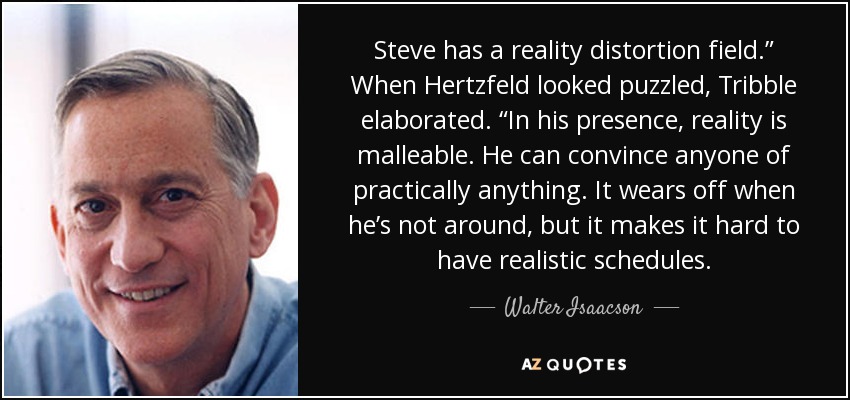Steve Jobs, co-founder of Apple, was known for his incredible vision. Walter Isaacson’s biography of Jobs reveals much about this iconic figure.
One key concept explored is Jobs’ “Reality Distortion Field. ” Jobs had a unique way of bending reality to fit his vision. This trait, often called the “Reality Distortion Field,” made the impossible seem possible. Walter Isaacson, in his biography of Jobs, delves deep into this phenomenon.
He explains how Jobs used this field to inspire his team, drive innovation, and push boundaries. Understanding this concept helps us see why Jobs was such a powerful and influential leader. Let’s explore how the “Reality Distortion Field” shaped Jobs’ remarkable journey and the tech world.

Credit: quotefancy.com
Introduction To Reality Distortion Field
Steve Jobs was famous for his Reality Distortion Field (RDF). This term describes his unique ability to convince himself and others of almost anything. Walter Isaacson’s biography on Jobs delves deeply into this phenomenon.
Concept Origin
The term Reality Distortion Field was first coined by Bud Tribble, a colleague at Apple. It refers to Jobs’ ability to bend reality to fit his vision. He could make the impossible seem possible. His RDF was a mix of charm, charisma, and determination.
Jobs’ RDF often led to breakthroughs. He could push teams to achieve what seemed unachievable. This mindset was pivotal at Apple.
Impact On Perception
Jobs’ RDF affected how people perceived him and his products. His strong belief in his ideas often made others believe too. This led to the creation of groundbreaking products like the iPhone and Mac.
The RDF also had downsides. Sometimes, it led to unrealistic expectations and stress for his team. Yet, many Apple employees believed the results were worth it.
In summary, Steve Jobs’ Reality Distortion Field was a crucial part of his legacy. It drove innovation and shaped the tech world.

Credit: www.azquotes.com
Steve Jobs And His Vision
Steve Jobs was known for his unique vision. He could see possibilities others could not. His reality distortion field helped him turn ideas into reality. Walter Isaacson’s biography of Jobs explores this in detail.
Early Influences
Jobs’s early life played a big role in shaping his vision. His father taught him to appreciate good craftsmanship. This attention to detail stayed with Jobs throughout his life.
Jobs was also influenced by Eastern spirituality. He traveled to India in search of enlightenment. This experience shaped his philosophy and approach to business.
Innovative Approach
Jobs had an innovative approach to technology and design. He believed in making products that were both beautiful and functional. This led to the creation of iconic products like the iPhone and the Mac.
Here are some key aspects of Jobs’s approach:
- Focus on simplicity
- Emphasis on user experience
- Attention to detail
- Commitment to quality
Jobs’s vision was not just about technology. It was about creating a better world through innovation. His legacy continues to inspire new generations of entrepreneurs and innovators.
The Role Of Reality Distortion In Apple
Steve Jobs’ Reality Distortion Field played a crucial role at Apple. This concept, coined by colleagues, describes Jobs’ ability to convince himself and others to believe almost anything. It helped Apple achieve remarkable feats and overcome challenges. Walter Isaacson’s biography of Steve Jobs highlights this phenomenon as central to Apple’s success.
Product Development
In product development, the Reality Distortion Field pushed the team beyond their limits. Jobs often demanded the impossible, but his belief made the team believe too. This led to innovations like the iPhone and MacBook. Employees worked longer hours and solved tough problems. They wanted to meet Jobs’ high expectations. This relentless drive resulted in groundbreaking products.
| Product | Key Feature | Impact |
|---|---|---|
| iPhone | Touchscreen | Revolutionized smartphones |
| MacBook | Sleek design | Set a new standard for laptops |
Marketing Strategies
Jobs’ Reality Distortion Field was not limited to product development. It extended to marketing strategies as well. Jobs believed in the power of storytelling. He crafted compelling narratives around Apple products. These stories made people feel like they needed Apple products in their lives. The marketing campaigns were simple yet powerful.
- Iconic “Think Different” campaign
- Memorable product launches
- Innovative ads highlighting product benefits
This approach created a loyal customer base. Apple products were seen as more than just gadgets. They became symbols of innovation and style.
Case Studies Of Reality Distortion
The Reality Distortion Field (RDF) is a term closely linked to Steve Jobs. This concept describes his ability to convince himself and others to believe in the impossible. Walter Isaacson’s biography of Steve Jobs highlights many instances of RDF. Here, we explore two key case studies.
Macintosh Launch
Steve Jobs used his RDF to push the Macintosh team to achieve great things. He set high expectations and deadlines. Many believed these were unachievable. Yet, Jobs convinced them otherwise. The team worked tirelessly, often around the clock. Jobs’ belief in the project was infectious. The result was the launch of the Macintosh in 1984. It was a game-changer in personal computing.
Iphone Revolution
The iPhone is another product where RDF played a big role. Many doubted the success of a touch-screen phone. Jobs insisted it was the future. He persuaded his team and the market to believe in the iPhone. They worked hard to make it a reality. In 2007, the iPhone was launched. It changed how people interacted with technology. RDF helped turn vision into reality.
Psychological Aspects
Walter Isaacson’s biography of Steve Jobs introduces the concept of the “reality distortion field.” This term describes Jobs’ unique ability to convince himself and others to believe in the impossible. Understanding the psychological aspects behind this phenomenon is crucial. It reveals how Jobs’ mindset impacted those around him and helped shape his success.
Charismatic Leadership
Steve Jobs was a master of charismatic leadership. People followed him not just because of his vision, but because of his magnetic personality. Jobs had a way of making people feel important and special. His charisma was not just natural; it was part of his strategy. He used it to inspire and motivate his team to achieve more than they thought possible.
Jobs often created an intense work environment. He pushed his employees to their limits. Yet, many of them remained loyal and dedicated. They believed in his vision and wanted to be part of something bigger. This shows how powerful charismatic leadership can be.
Persuasion Techniques
Jobs used several persuasion techniques to create his reality distortion field. He was known for his ability to bend reality to his will. Here are some techniques he used:
- Reframing: He would present challenges as opportunities.
- Passion: He spoke with such enthusiasm that others believed in his vision.
- Selective Reality: He focused on the positive aspects and ignored the negatives.
One of Jobs’ key techniques was to set impossible deadlines. He convinced his team that they could meet these deadlines, even when it seemed unrealistic. Surprisingly, they often did. His belief in their abilities pushed them to perform at their best.
Jobs also used a technique called repetition. He would repeat his ideas and goals until everyone believed in them. This constant reinforcement helped to solidify his vision in the minds of his team.
| Technique | Description |
|---|---|
| Reframing | Presenting challenges as opportunities |
| Passion | Speaking with enthusiasm |
| Selective Reality | Focusing on positives, ignoring negatives |
| Impossible Deadlines | Setting unrealistic goals |
| Repetition | Constantly reinforcing ideas and goals |
Impact On Team Dynamics
The reality distortion field (RDF) of Steve Jobs had a profound impact on team dynamics at Apple. RDF is a term used to describe Jobs’ ability to convince himself and others to believe in the impossible. This had both positive and negative effects on his team. It influenced employee motivation and creative collaboration significantly.
Employee Motivation
Steve Jobs’ RDF often pushed employees beyond their limits. Many employees felt inspired to achieve more than they thought possible. Jobs set high expectations, which could be both exhilarating and stressful.
Motivation was often driven by Jobs’ unwavering belief in the product. He made employees feel they were part of something revolutionary. This belief created a sense of urgency and importance in their work.
Here are some ways RDF impacted employee motivation:
- Employees felt a strong sense of purpose.
- They experienced increased job satisfaction from achieving difficult goals.
- High expectations led to personal and professional growth.
Creative Collaboration
The RDF also affected how teams collaborated creatively. Jobs’ vision required out-of-the-box thinking. Teams often had to rethink traditional approaches. This fostered an environment of innovation.
Collaboration under RDF had unique dynamics:
- Teams were encouraged to challenge norms.
- Creative solutions were prioritized over conventional ones.
- Cross-functional collaboration became crucial for problem-solving.
Although challenging, this environment promoted unique solutions and breakthroughs. Teams learned to work under pressure and adapt quickly.
Criticism And Controversy
Walter Isaacson’s biography of Steve Jobs reveals many facets of the tech icon’s personality. One of the most talked-about aspects is Jobs’ famous “Reality Distortion Field” (RDF). While this trait enabled him to push boundaries, it also drew significant criticism and controversy. In this section, we will explore the aspects that made the RDF a polarizing topic.
Reality Vs. Illusion
Steve Jobs had a unique ability to make people believe in his vision. This often meant bending reality to fit his narrative. Some saw it as inspirational. Others saw it as manipulative. Jobs’ RDF allowed him to convince his team that the impossible was possible. This sometimes led to remarkable innovations. But it also led to stress and burnout.
In Walter Isaacson’s biography, many employees described feeling trapped in a cycle of constant pressure. They were often pushed beyond their limits. Some critics argue that Jobs’ RDF created a toxic work environment. They believe it blurred the lines between reality and illusion.
Ethical Considerations
The ethical implications of Jobs’ RDF have been widely debated. On one hand, it drove the development of groundbreaking products. On the other hand, it raised questions about leadership ethics. Was it fair to demand so much from employees? Some believe that Jobs’ methods were justified by the results. Others think it was an abuse of power.
Employee well-being was often sacrificed for the sake of innovation. Many former employees reported feeling undervalued. They felt their personal lives were neglected. This raises important ethical questions. Can great achievements excuse poor treatment of workers? Isaacson’s biography does not shy away from these tough questions.
| Pros of RDF | Cons of RDF |
|---|---|
| Inspires innovation | Leads to burnout |
| Pushes boundaries | Creates stress |
| Achieves the impossible | Blurs reality |
Legacy Of Steve Jobs
Steve Jobs left a legacy that continues to shape the world. Walter Isaacson’s biography captures this impact, especially through the concept of the “Reality Distortion Field.” Jobs’ ability to inspire and drive innovation remains unmatched.
Enduring Influence
Steve Jobs’ influence extends far beyond Apple. Many industries still feel his impact. His vision for elegant, user-friendly design changed technology. Today, companies strive to emulate his focus on simplicity and functionality.
Jobs’ insistence on quality revolutionized product development. Teams aim for perfection, not just completion. This approach leads to better products and happier customers.
| Area | Impact |
|---|---|
| Design | Simple, elegant, intuitive |
| Product Development | Focus on quality and user experience |
| Innovation | Encouraged creative thinking and risk-taking |
Lessons For Future Leaders
Steve Jobs taught many valuable lessons for future leaders. Understanding his methods can guide new innovators.
- Vision: Have a clear and compelling vision. Inspire others to follow it.
- Quality: Never compromise on quality. Strive for excellence in every detail.
- Perseverance: Face challenges head-on. Use setbacks as learning opportunities.
- Innovation: Encourage creativity. Foster an environment where new ideas flourish.
Leaders can learn from Jobs’ focus on the user experience. Always consider how products and services affect end-users.
Jobs’ legacy is a powerful reminder of the impact of visionary leadership. By studying his approach, future leaders can drive their own success.

Credit: www.linkedin.com
Frequently Asked Questions
What Is The Reality Distortion Field?
The Reality Distortion Field (RDF) is a term used to describe Steve Jobs’ persuasive charisma. He could convince people to believe in his vision, often leading them to achieve seemingly impossible tasks.
How Did Steve Jobs Use Rdf?
Steve Jobs used RDF to inspire and motivate his team. He pushed them to exceed their limits and achieve extraordinary results, often creating groundbreaking products.
Why Is Rdf Significant In Steve Jobs’ Leadership?
RDF is significant because it showcases Jobs’ unique ability to drive innovation. His leadership style and persuasive skills were key to Apple’s success and transformation into a tech giant.
Can Rdf Be Considered A Positive Trait?
Yes, RDF can be positive as it fosters creativity and innovation. However, it also has downsides, such as unrealistic expectations and potential burnout among team members.
Conclusion
The reality distortion field shaped Steve Jobs’ legacy profoundly. His vision and determination inspired innovation. Many learned to see beyond limitations. Jobs pushed boundaries, creating products we use daily. His unique perspective influenced technology’s evolution. Understanding this helps appreciate his contributions better.
The reality distortion field changed perceptions and drove success. Steve Jobs remains a symbol of creativity and ambition. His impact on the tech world continues to resonate.









